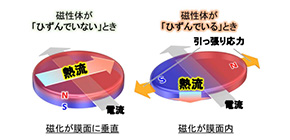
Strain application to a substrate can change heat current direction in devices
Researchers from the Institute of Scientific and Industrial Research of Osaka University, in cooperation with The University of Tokyo, National Institute for Materials Science (NIMS), and Toyota Technological Institute, demonstrated that it was possible to actively control heat current generated in a metallic magnetic thin film of a few to a dozen nanometers in thickness by applying a tensile strain to the metallic magnet.
This novel method for controlling thermal energy was realized by the combination of (a) spin caloritronics phenomena (i.e., thermo-spin effects in which the conversion property between heat and charge currents depends on the magnetization direction in magnetic systems) and (b) magnetoelastic effects (i.e., the change of a material's magnetic property under mechanical strain).
The researchers fabricated a perpendicularly magnetized nanoscale terbium iron cobalt (TbFeCo) film on a flexible substrate. Under strain-free conditions, magnetization of this film lies in the film plane. Stretching the substrate switches the magnetic axis from the perpendicular-to-plane to the in-plane direction due to the magnetoelastic effect, resulting in a 90° rotation at zero external magnetic field. Along with that, the direction of heat current caused by spin caloritronics also changes 90 degrees, because the direction of heat current is determined by the direction of magnetization.
They measured thermal diffusion of current flow in nickel (Ni) and TbFeCo films, which were processed into Π-shaped wires, on a flexible substrate, temperature modulation with the sign reversal occurred at the edges of the Π-shaped wires under strain-free conditions. This means that heat current occurs in the Π-shaped thin wire direction due to spin caloritronics. Strain application to the metallic magnetized film caused thermal diffusion, generating heat in perpendicular-to-plane direction.
With the miniaturization in electronics devices, how to deal with Joule heating, i.e., how to dissipate and manage heat in micro- and nano- electronic devices, becomes important. Thus, the development of novel principles and functions of active thermal management is indispensable.
Current-induced temperature modulation in this study was small; however, improving heating/cooling abilities by developing magnetic materials that exhibit spin caloritronics phenomena and optimal thermal designing will lead to the development of technology for controlling thermal energy in nanoscale electronic devices.
Moving forward, it may become possible to control thermal energy not by a mechanical method as shown in this study, but by an energy saving electric method, e.g., controlling the direction of magnetization by applying a voltage. This group’s achievements will give a new direction to spin caloritronics and facilitate the development of thermal energy management, technologies vital to nanoscale electronic devices.
Figure 1
Figure 2
The article “Strain-induced switching of heat current direction generated by magnetothermoelectric effects,” was published in Scientific Reports at DOI: https://doi.org/10.1038/s41598-019-49567-2 .
Related links
